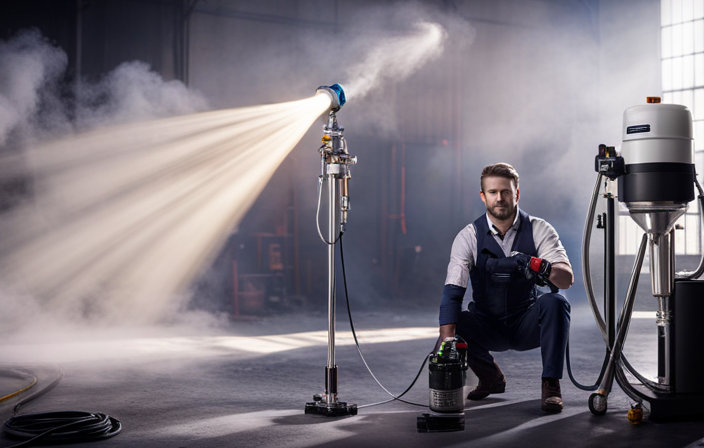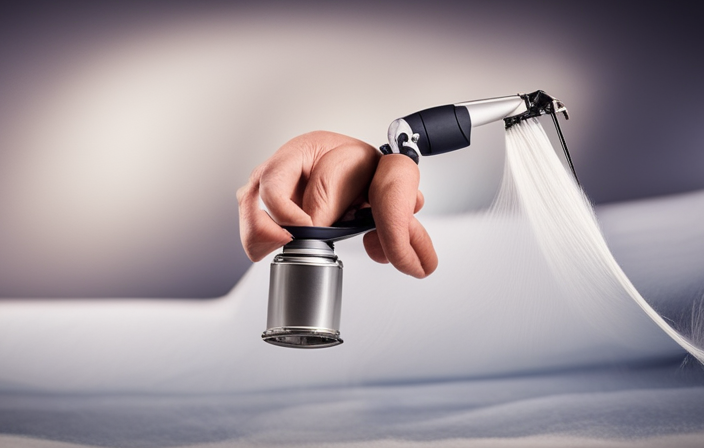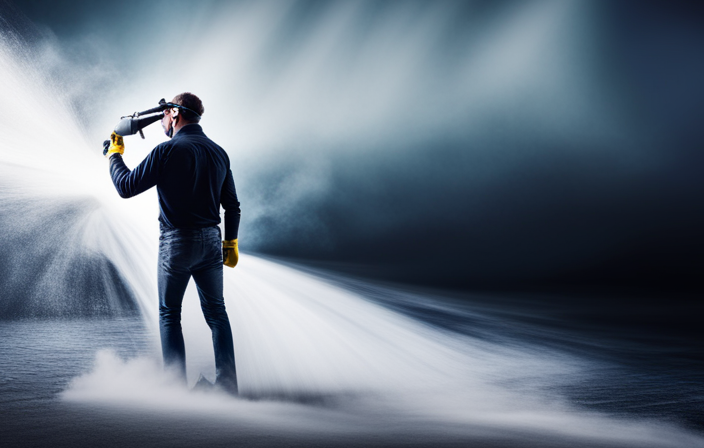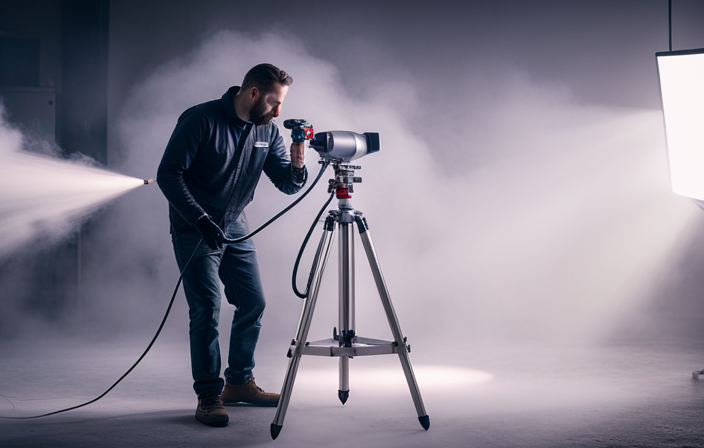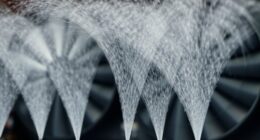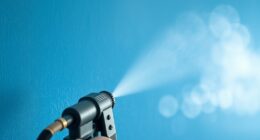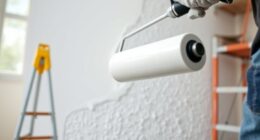“Many have heard the saying that a picture is worth a thousand words, but sometimes it takes the right tools to bring that image to life. That’s where airless paint sprayers come in. These powerful machines are a valuable asset to any painter, allowing for quick and efficient paint application on various surfaces.”
But do you know what all the parts on an airless paint sprayer are called? Well, fear not, because I’m here to break it down for you.
First up, we have the pump, the heart of the sprayer that pressurizes the paint.
Then there’s the nozzle, which controls the flow and pattern of the paint.
Connected to the pump is the hose, carrying the paint from the tank to the gun.
Ah, yes, the gun, where the magic happens as you pull the trigger and release a stream of color.
And let’s not forget the pressure control knob, prime valve, manifold, tank, and motor, all working together to make your painting experience a breeze.
So, if you’re ready to dive into the world of airless paint sprayers, let’s get acquainted with their parts and unleash your inner artist.
Key Takeaways
- Filters: Regularly clean and maintain filters for smooth paint flow and to prevent clogs.
- Prime Valve: Use the prime valve to easily prime the pump and remove air bubbles for improved performance and reduced maintenance.
- Manifold: Inspect and clean the manifold regularly to control paint flow and pressure, and troubleshoot any leaks or uneven spray patterns.
- Nozzle: Clean and inspect the nozzle regularly, replace worn-out or damaged nozzles, and maintain proper spray pattern and paint flow for desired results.
The Pump
Before you can effectively operate an airless paint sprayer, it’s important to understand how the pump works. The pump is the heart of the sprayer and is responsible for pressurizing the paint and delivering it to the nozzle.
The pump uses a piston mechanism to create high pressure, which forces the paint out of the sprayer. Depending on the model of the sprayer, this mechanism is powered by an electric motor or a gas engine.
To troubleshoot common pump issues, there are a few steps you can take. First, check for any clogs or blockages in the paint intake or discharge valves. If you find any, be sure to clean them thoroughly. Next, inspect the piston for any signs of wear or damage. If you notice any issues, it’s best to replace the piston. Lastly, make sure the pump is properly lubricated and that all connections are tight.
Now that you have a better understanding of how the pump works and how to troubleshoot common issues, let’s move on to the next section about ‘the nozzle’.
The Nozzle
The nozzle on an airless paint sprayer is like a precision jet, delivering a focused stream of color with surgical accuracy. It plays a crucial role in the paint application process, and understanding its maintenance and choosing the right nozzle are essential.
Here are three important things to know about the nozzle:
-
Nozzle maintenance: Regular cleaning and inspection of the nozzle are necessary to ensure optimal performance. Paint buildup or debris can affect the spray pattern and result in uneven coverage. By keeping the nozzle clean, you can prevent clogs and achieve consistent results.
-
Choosing the right nozzle: Different nozzles have varying spray patterns and flow rates. Understanding the project requirements and the specific paint being used will help in selecting the appropriate nozzle. Factors like the desired coverage, surface type, and paint viscosity should be considered to achieve the best results.
-
Nozzle size and pressure: The nozzle size and the pressure setting on the sprayer affect the spray pattern and the amount of paint being delivered. Adjusting these factors allows for greater control over the application, enabling you to achieve the desired finish.
Now, let’s move on to the next component, the hose, which is responsible for delivering paint from the sprayer to the surface.
The Hose
Connected to the powerful machine, the hose transports the vibrant color effortlessly, ensuring a smooth and precise application on any surface.
When using an airless paint sprayer, the hose plays a crucial role in delivering the paint from the machine to the surface being painted.
The benefits of using an airless paint sprayer with a hose include increased speed, reduced overspray, and the ability to cover large areas in less time.
To choose the right hose for your airless paint sprayer, consider factors such as the length, diameter, and material of the hose.
Longer hoses are ideal for reaching higher or farther areas, while larger diameter hoses allow for a higher flow rate.
Additionally, hoses made of durable materials, such as polyurethane or nylon, ensure longevity and resistance to chemicals.
Transitioning into the next section about ‘the gun’, the hose connects seamlessly to this essential component, allowing for precise control over the paint flow.
The Gun
The gun, equipped with a trigger, allows for precise control over the flow of paint. This essential component of an airless paint sprayer is responsible for delivering the paint onto the surface being painted. The gun connects to the pump, which creates the necessary pressure to propel the paint through the gun.
Here are three important parts of the gun:
-
Nozzle: The nozzle determines the pattern and size of the paint spray. Different nozzles can be used for various applications, such as wide surfaces or detailed work.
-
Filter: The gun is equipped with a filter to ensure that no debris or contaminants enter the paint stream, resulting in a smooth and even finish.
-
Trigger Lock: The gun often features a trigger lock mechanism, allowing for continuous spraying without straining the hand.
Transitioning to the next section, let’s move on to discussing the pressure control knob, which plays a crucial role in adjusting the output pressure of the sprayer.
The Pressure Control Knob
The pressure control knob is a crucial component of an airless paint sprayer. It allows you to fine-tune the pressure to achieve the desired spray pattern and coverage. By turning the knob clockwise, you increase the pressure, resulting in a narrower spray pattern and more forceful paint application. On the other hand, turning the knob counterclockwise decreases the pressure, creating a wider spray pattern and gentler application.
These pressure control techniques give you the ability to adapt to different surfaces and project requirements, ensuring optimal results every time.
Now, let’s move on to the next section and discuss another important part of the airless paint sprayer: the filter.
The Filter
The filter is an essential component of an airless paint sprayer. It removes impurities from the paint, ensuring a smooth and flawless finish. There are different types of filters available, such as mesh filters and fine filters. These can be selected based on the type of paint being used.
To maintain the filter’s effectiveness, it is important to clean and replace it regularly. A clogged or dirty filter can lead to inconsistent spray patterns and paint defects.
Removes impurities from the paint
To achieve a flawless finish, it’s important to ensure that impurities are effectively removed from the paint before it is sprayed. Using a paint strainer in airless paint sprayers offers several benefits:
- It helps prevent clogs in the spray tip, ensuring a consistent and uninterrupted flow of paint.
- It removes debris such as dust, dirt, and dried paint particles, resulting in a smoother application.
- It improves the overall quality of the finish by eliminating any potential imperfections caused by impurities.
- It prolongs the life of the sprayer by preventing damage from particles that could clog or damage internal components.
- It saves time and money by reducing the need for rework or touch-ups caused by impurities in the paint.
Proper paint preparation is crucial for optimal results in airless paint spraying. In the next section, we will discuss the different types of filters and provide maintenance tips to ensure effective impurity removal.
Types of filters and maintenance tips
Using a paint strainer in airless paint sprayers is like having a bouncer at a club, filtering out all the unwanted impurities from entering and spoiling the party.
There are different types of filters available for airless paint sprayers, including mesh filters and tip filters.
Mesh filters are typically made of stainless steel and are designed to catch larger particles.
Tip filters, on the other hand, are located at the tip of the spray gun and are responsible for catching smaller particles.
To properly maintain the filters, it is important to regularly clean them using appropriate cleaning solutions.
This will help prevent clogs and ensure smooth paint flow.
If you encounter any issues with the filters, such as decreased spray pattern or paint spitting, troubleshooting common issues like checking for blockages or replacing worn-out filters can often resolve the problem.
Now, let’s move on to discussing the prime valve.
The Prime Valve
The prime valve is an essential component of an airless paint sprayer. It allows for easy priming of the pump. To effectively use the prime valve, simply turn it counterclockwise to open it. Then, pull the trigger on the spray gun. This action will draw paint into the pump and remove any air bubbles. This ensures a smooth and consistent spray.
Allows for easy priming of the pump
When you’re ready to start painting, simply attach the paint hose to the sprayer and get ready for hassle-free priming of the pump. The prime valve on an airless paint sprayer allows for easy priming of the pump, ensuring smooth and efficient operation.
Here are three key benefits of using the prime valve:
-
Time-saving: With the prime valve, you can quickly and effortlessly prime the pump, saving you valuable time during your painting projects.
-
Reduced maintenance: By properly priming the pump, you can prevent issues such as clogs and uneven spraying, reducing the need for frequent pump maintenance.
-
Improved performance: When the pump is properly primed, it ensures consistent pressure and flow, resulting in a high-quality finish with every stroke.
Now that you know the benefits of using the prime valve, let’s explore how to effectively use it for optimal results.
How to use the prime valve effectively
To effectively use the prime valve on an airless paint sprayer, follow these steps:
- Attach your paint hose and turn on the sprayer.
- Locate the prime valve, typically near the pump.
- Turn the valve to the ‘prime’ position and listen for the sound of paint flowing through the system. This primes the pump for optimal performance.
- Once priming is complete, switch the valve back to the ‘spray’ position to start painting.
To maintain the prime valve’s effectiveness, regularly clean it using proper cleaning methods. Additionally, be aware of common issues like clogs or leaks and troubleshoot as needed.
Now, let’s move on to the next important component of an airless paint sprayer: the manifold.
The Manifold
To truly experience the power of an airless paint sprayer, picture yourself gripping the ergonomic handle of the manifold and effortlessly gliding it across the surface, transforming it with a flawless coat of paint.
The manifold is a crucial component of the paint sprayer, responsible for controlling the flow and pressure of the paint. Proper manifold maintenance is essential to ensure optimal performance.
Regularly inspect the manifold for any signs of wear or damage, and clean it thoroughly after each use to prevent clogs. If you encounter common manifold issues such as leaks or uneven spray patterns, troubleshooting techniques can help identify and resolve the problem.
Now, let’s move on to the next section about ‘the tank’, where we’ll explore another important part of the airless paint sprayer.
The Tank
After learning about the manifold, let’s now focus on another important part of an airless paint sprayer: the tank.
The tank, also known as the reservoir, is where the paint is stored before it is sprayed onto the surface. Its capacity plays a crucial role in the efficiency of the painting process. A larger tank allows for more paint to be stored, reducing the need for frequent refills and increasing productivity. On the other hand, a smaller tank might require more frequent refills, leading to interruptions and slower progress.
Proper cleaning and maintenance of the tank is essential for its long-term use. Regularly removing any residual paint and keeping it clean ensures optimal performance and prevents clogs or blockages.
Now, let’s move on to the next section about the motor, which is responsible for powering the entire airless paint sprayer system.
The Motor
Get ready to experience the power behind the entire airless paint sprayer system – the motor. It can be likened to the beating heart that brings life to your painting projects.
The motor is responsible for driving the pump that pushes the paint through the system and onto your desired surface. To ensure optimal performance and longevity, proper motor maintenance is crucial.
Here are three key tips for motor maintenance:
-
Regular cleaning: Keep the motor free from dust, debris, and paint overspray by wiping it down after each use. This will prevent any build-up that could potentially affect the motor’s performance.
-
Lubrication: Check the motor’s bearings and other moving parts regularly and apply lubricant as needed. This will help reduce friction and keep the motor running smoothly.
-
Troubleshooting motor issues: If you encounter any motor-related problems such as overheating or unusual noises, refer to the manufacturer’s manual for troubleshooting steps. It is important to address these issues promptly to avoid further damage and ensure your airless paint sprayer’s reliability.
Frequently Asked Questions
How do I properly clean and maintain the airless paint sprayer motor?
To properly clean and maintain the airless paint sprayer motor, I recommend following these steps. First, disconnect the power source and remove any excess paint. Then, use a soft brush or cloth to remove dust and debris. Finally, lubricate the motor as instructed by the manufacturer.
What are the common causes of clogging in the nozzle and how can I prevent it?
To prevent nozzle clogging in an airless paint sprayer, it’s important to understand the common causes. Lack of proper cleaning, using low-quality paint, and spraying at too high a pressure can all lead to clogs. Regular maintenance and cleaning are key to preventing this issue.
Can I use any type of paint with an airless paint sprayer, or are there specific types that work best?
You can use different types of paint with an airless paint sprayer, but some may work better than others. Oil-based paints offer better adhesion and durability, while latex paints are easier to clean up.
How do I troubleshoot and fix any issues with the pressure control knob?
To troubleshoot and fix pressure control knob issues, start by checking for clogs or blockages in the nozzle or hose. Adjust the knob gradually to find the optimal pressure. If the issue persists, consult the user manual or contact customer support for further assistance.
Are there any safety precautions I should take when using an airless paint sprayer, especially in terms of handling the gun and nozzle?
When using an airless paint sprayer, it’s important to take handling precautions and properly maintain the nozzle. This includes wearing protective gear, avoiding spraying towards people, and cleaning the nozzle regularly to prevent clogs and ensure smooth operation.
Conclusion
So there you have it, folks! Those are the basic parts of an airless paint sprayer. As I was learning about these different components, I couldn’t help but think of a well-orchestrated symphony.
Each part plays its own unique role, just like the instruments in an orchestra. The pump provides the power, the nozzle controls the flow, the hose delivers the paint, and the gun is the conductor, directing it all.
It’s truly amazing how these parts work together seamlessly to create a beautiful masterpiece on any surface.
